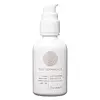What's inside
What's inside
 Key Ingredients
Key Ingredients

 Benefits
Benefits

 Concerns
Concerns

No concerns
 Ingredients Side-by-side
Ingredients Side-by-side

Butyl Methoxydibenzoylmethane 3%
UV AbsorberHomosalate 10%
Skin ConditioningEthylhexyl Salicylate 5%
UV AbsorberOctocrylene 10%
UV AbsorberWater
Skin ConditioningStyrene/Acrylates Copolymer
Silica
AbrasiveDimethicone
EmollientPotassium Cetyl Phosphate
EmulsifyingBenzyl Alcohol
PerfumingBeeswax
Emulsion StabilisingCaprylyl Methicone
Skin ConditioningGlyceryl Stearate
EmollientPEG-100 Stearate
Cetyl Dimethicone
EmollientCaprylyl Glycol
EmollientEthylhexylglycerin
Skin ConditioningAluminum Starch Octenylsuccinate
AbsorbentBehenyl Alcohol
EmollientAcrylates/Dimethicone Copolymer
Skin ConditioningXanthan Gum
EmulsifyingSodium Polyacrylate
AbsorbentChlorphenesin
AntimicrobialDimethicone/PEG-10/15 Crosspolymer
Hydrolyzed Jojoba Esters
Skin ConditioningParfum
MaskingDisodium EDTA
Ethylhexyl Stearate
EmollientTocopheryl Acetate
AntioxidantBHT
AntioxidantTrideceth-6
EmulsifyingJojoba Esters
EmollientButyl Methoxydibenzoylmethane 3%, Homosalate 10%, Ethylhexyl Salicylate 5%, Octocrylene 10%, Water, Styrene/Acrylates Copolymer, Silica, Dimethicone, Potassium Cetyl Phosphate, Benzyl Alcohol, Beeswax, Caprylyl Methicone, Glyceryl Stearate, PEG-100 Stearate, Cetyl Dimethicone, Caprylyl Glycol, Ethylhexylglycerin, Aluminum Starch Octenylsuccinate, Behenyl Alcohol, Acrylates/Dimethicone Copolymer, Xanthan Gum, Sodium Polyacrylate, Chlorphenesin, Dimethicone/PEG-10/15 Crosspolymer, Hydrolyzed Jojoba Esters, Parfum, Disodium EDTA, Ethylhexyl Stearate, Tocopheryl Acetate, BHT, Trideceth-6, Jojoba Esters
Camellia Sinensis Leaf Water
MaskingCaprylic/Capric Triglyceride
MaskingCoco-Caprylate
EmollientGlycerin
HumectantPolyglyceryl-6 Stearate
EmollientCapryloyl Glycerin/Sebacic Acid Copolymer
Skin ConditioningWater
Skin ConditioningOryza Sativa Bran Extract
Skin ConditioningSqualane
EmollientPolyhydroxystearic Acid
EmulsifyingHippophae Rhamnoides Seed Oil
Skin ProtectingSilybum Marianum Ethyl Ester
Skin ConditioningPisum Sativum Peptide
Skin ConditioningTerminalia Chebula Fruit Extract
Skin ConditioningHaematococcus Pluvialis Powder
AntioxidantSimmondsia Chinensis Seed Oil
EmollientAloe Barbadensis Leaf Juice
Skin ConditioningCamellia Sinensis Leaf Extract
AntimicrobialCitrus Aurantium Amara Flower Cera
Skin ProtectingIsopropyl Jojobate
EmollientJojoba Alcohol
EmollientJojoba Esters
EmollientXanthan Gum
EmulsifyingPolyglyceryl-6 Behenate
Emulsion StabilisingLactic Acid
BufferingAcacia Senegal Gum
MaskingDipotassium Glycyrrhizate
HumectantAllantoin
Skin ConditioningPhenethyl Alcohol
MaskingEthylhexylglycerin
Skin ConditioningSodium Phytate
Leuconostoc/Radish Root Ferment Filtrate
AntimicrobialTocopherol
AntioxidantCamellia Sinensis Leaf Water, Caprylic/Capric Triglyceride, Coco-Caprylate, Glycerin, Polyglyceryl-6 Stearate, Capryloyl Glycerin/Sebacic Acid Copolymer, Water, Oryza Sativa Bran Extract, Squalane, Polyhydroxystearic Acid, Hippophae Rhamnoides Seed Oil, Silybum Marianum Ethyl Ester, Pisum Sativum Peptide, Terminalia Chebula Fruit Extract, Haematococcus Pluvialis Powder, Simmondsia Chinensis Seed Oil, Aloe Barbadensis Leaf Juice, Camellia Sinensis Leaf Extract, Citrus Aurantium Amara Flower Cera, Isopropyl Jojobate, Jojoba Alcohol, Jojoba Esters, Xanthan Gum, Polyglyceryl-6 Behenate, Lactic Acid, Acacia Senegal Gum, Dipotassium Glycyrrhizate, Allantoin, Phenethyl Alcohol, Ethylhexylglycerin, Sodium Phytate, Leuconostoc/Radish Root Ferment Filtrate, Tocopherol
 Reviews
Reviews

Ingredients Explained
These ingredients are found in both products.
Ingredients higher up in an ingredient list are typically present in a larger amount.
Ethylhexylglycerin (we can't pronounce this either) is commonly used as a preservative and skin softener. It is derived from glyceryl.
You might see Ethylhexylglycerin often paired with other preservatives such as phenoxyethanol. Ethylhexylglycerin has been found to increase the effectiveness of these other preservatives.
Jojoba Esters is a wax created from Jojoba oil. It is an emollient and film-forming ingredient. In bead form, it is an exfoliator.
This ingredient has high oxidative stability, meaning it doesn't break down when exposed to oxygen.
Its similarity to our skin's natural oils makes it a great emollient. Emollients help soften and soothe our skin by creating a barrier on top. This barrier helps trap moisture in, keeping skin hydrated.
It is created using either the hydrogenation or transesterification processes on jojoba oil.
Learn more about Jojoba EstersWater. It's the most common cosmetic ingredient of all. You'll usually see it at the top of ingredient lists, meaning that it makes up the largest part of the product.
So why is it so popular? Water most often acts as a solvent - this means that it helps dissolve other ingredients into the formulation.
You'll also recognize water as that liquid we all need to stay alive. If you see this, drink a glass of water. Stay hydrated!
Learn more about WaterXanthan gum is used as a stabilizer and thickener within cosmetic products. It helps give products a sticky, thick feeling - preventing them from being too runny.
On the technical side of things, xanthan gum is a polysaccharide - a combination consisting of multiple sugar molecules bonded together.
Xanthan gum is a pretty common and great ingredient. It is a natural, non-toxic, non-irritating ingredient that is also commonly used in food products.
Learn more about Xanthan Gum